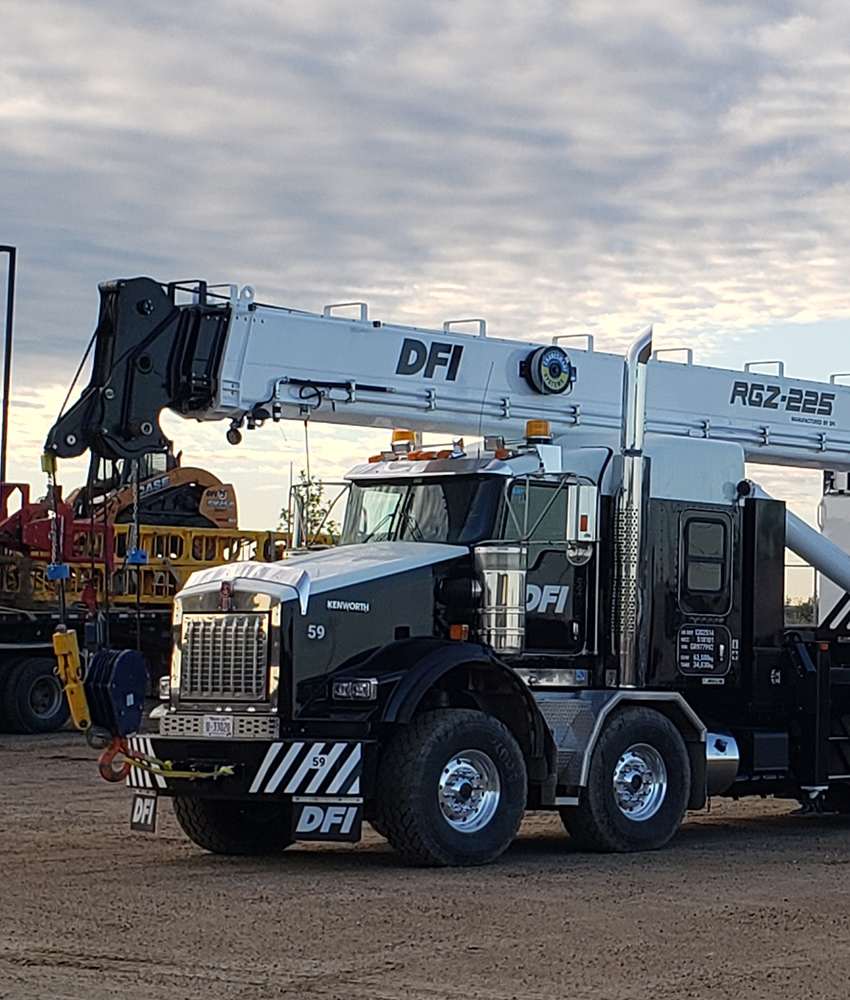Many of us enjoyed a meet and greet with the latest RGZ-225, 45-ton picker when it rolled out of the assembly shop for the 50th anniversary where it received a flood of positive attention.
This most recent build incorporated a number of updates and modifications to keep DFI ahead of the pack—all thanks to the great feedback received from shop and field staff.
Improved camera system with a larger display and two cameras. One to provide a line of sight for the blind-spot over the operator’s right shoulder regardless of the swing cab position, and another to keep the winches in view.
- The outrigger plumbing has been improved and features a bulkhead at the rear of the chassis. This makes it easier to replace a section of hose prone to wear without pulling the entire length from the rear to the front outrigger valve bank.
- Outrigger controls on the previous version were programmed on the touch screen—the intent was to simplify the cab and reduce maintenance potential. However this move garnered a poor approval rating from those using the machine daily. The screen option has been replaced with paddle joysticks and proportional control on both the up/down and extend/retract functions allowing the operator to control the rate of travel. This is a big plus in tight areas and will improve efficiency.
- A properly specked oil level gauge and a latch style hydraulic tank fill port lid has been added to the hydraulic tank. This eliminates the guess work and ensures the level is correct during pre-start inspections. It also provides improved access when adding oil. Put that pipe wrench away!
- A pull out step has been installed under the swing cab door for better access and egress.
- The addition of a defrost heater unit under the dash will provide additional heat and defrost capability in the winter and better focus the overall air flow in the cab—while also improving the A/C capability.
- Joystick pedestals have been moved from the armrest to a seat platform that includes two axes of adjustment, plus the armrest provides a separate means of adjustment.
- The boom rest has been re-designed from a cradle/platform to a ball and socket. This will take away the guesswork on placement and provide better overall support—in both routine and emergency situations.
- The CraneSmart system has been updated to include key features to help improve the level of safety for the operator and those working around the crane. The load chart has been incorporated into the system so it can monitor the load moment and provide feedback to the operator. Whether real time status and information audible alarms warning the operator of reached capacity, or shutdown when overcapacity. It does all of this with an increased number of input sensors such as; boom length indicator, crane level indicator, boom angle indicator, scale, and A2B switches. These features also display real time measurements for reference.
There have been some significant changes made to the hydraulic system. The fixed displacement, triple vein pump has been replaced with tandem variable displacement open loop piston pumps. These pumps provide more flow, more efficiently, and smoother power. They impose less wear and tear on the system, and will save on maintenance and reduce down time. The pumps are paired with the familiar valve components with the previously troublesome open center inlet replaced with a closed center inlet. This closed center inlet is capable of more flow and less moving parts—again, saving on maintenance and reducing down time—no more faulty inlets.
Installing new piston pumps opened an opportunity to improve the unit’s cooling capability—similar to the tracked fleet. The upgrade includes a small cooler in the boom rest that cools the case drain oil from the pumps prior to its return to the tank. This technique keeps normal operating temperatures lower and eliminates the need for two large coolers on the turret. The space saved from the second cooler leaves room for a rigging toolbox, and transfers weight from the steering (and it looks pretty good to!).
My favourite feature of the unit? That sharp black and white Kenworth T800 chassis with the raised studio sleeper molded to fit the boom.
It can’t be denied. Number 59 is one of the most eye catching boom trucks on the road. — TYLER BARRETT, Assembly Manager
